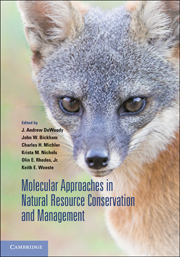Book contents
- Frontmatter
- Contents
- Contributors
- Preface
- 1 Biodiversity discovery and its importance to conservation
- 2 Gene flow, biodiversity, and genetically modified crops: Weedy rice in Thailand
- 3 A community and ecosystem genetics approach to conservation biology and management
- 4 Vertebrate sex-determining genes and their potential utility in conservation, with particular emphasis on fishes
- 5 Historical and contemporary dynamics of adaptive differentiation in European oaks
- 6 Association genetics, population genomics, and conservation: Revealing the genes underlying adaptation in natural populations of plants and animals
- 7 Hybridization in threatened and endangered animal taxa: Implications for conservation and management of biodiversity
- 8 Pollen and seed movement in disturbed tropical landscapes
- 9 Implications of landscape alteration for the conservation of genetic diversity of endangered species
- 10 Integrating evolutionary considerations into recovery planning for Pacific salmon
- 11 Using molecular methods to improve the genetic management of captive breeding programs for threatened species
- 12 Wildlife reintroductions: The conceptual development and application of theory
- 13 Evolutionary toxicology
- Index
- Plates
- References
7 - Hybridization in threatened and endangered animal taxa: Implications for conservation and management of biodiversity
Published online by Cambridge University Press: 05 July 2014
- Frontmatter
- Contents
- Contributors
- Preface
- 1 Biodiversity discovery and its importance to conservation
- 2 Gene flow, biodiversity, and genetically modified crops: Weedy rice in Thailand
- 3 A community and ecosystem genetics approach to conservation biology and management
- 4 Vertebrate sex-determining genes and their potential utility in conservation, with particular emphasis on fishes
- 5 Historical and contemporary dynamics of adaptive differentiation in European oaks
- 6 Association genetics, population genomics, and conservation: Revealing the genes underlying adaptation in natural populations of plants and animals
- 7 Hybridization in threatened and endangered animal taxa: Implications for conservation and management of biodiversity
- 8 Pollen and seed movement in disturbed tropical landscapes
- 9 Implications of landscape alteration for the conservation of genetic diversity of endangered species
- 10 Integrating evolutionary considerations into recovery planning for Pacific salmon
- 11 Using molecular methods to improve the genetic management of captive breeding programs for threatened species
- 12 Wildlife reintroductions: The conceptual development and application of theory
- 13 Evolutionary toxicology
- Index
- Plates
- References
Summary
Hybridization between species often results in offspring that are less fit than pure parental forms and may result in selection for traits that enhance prezygotic barriers to gene flow (a process known as reinforcement). Evolutionary biologists also recognize a role for interspecific hybridization in promoting the evolution of novel forms (Stebbins 1950; Anderson & Stebbins 1954; Harrison 1993a,b; Rhymer & Simberloff 1996; Arnold 1997). Natural hybridization occurs relatively frequently among divergent populations or species of plants and animals (Stace 1975; Barton & Bengtsson 1986; Grant & Grant 1992; Mallet 2005), and, despite the relative rarity of hybrids in any single population, only a few are needed to allow the exchange of advantageous alleles between species (i.e., introgression). The historical admixture of genomes has also contributed to speciation, especially in plants but also in some animal taxa (Arnold 1997; Dowling & Secor 1997; Mallet 2005; Gompert et al. 2006; Mavárez et al. 2006; Grant & Grant 2008).
In conservation biology, the predominant view is that introgressive hybridization is a cause of extinction (Rhymer & Simberloff 1996; Wolf et al. 2001), especially when hybridization events are anthropogenically mediated. Previously allopatric species are now commonly brought into contact due to anthropogenic introductions (Pysek et al. 1995). Likewise, previously parapatric or sympatric species now commonly hybridize due to human-induced changes in the environment that reduce elements of habitat heterogeneity that once contributed to diversification and maintained species independence (e.g., through ecological isolation; see Candolin et al. 2006; Hendry et al. 2006; Seehausen et al. 2008). Some have argued that this “smoothing” of landscapes is equivalent to a “speciation reversal,” a process that will become increasingly common in changing environments (Seehausen et al. 2008).
- Type
- Chapter
- Information
- Publisher: Cambridge University PressPrint publication year: 2010
References
- 3
- Cited by



